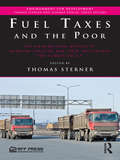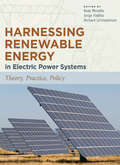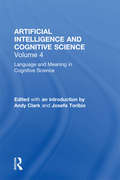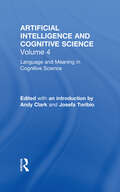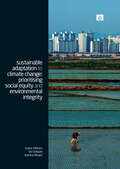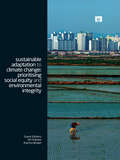- Table View
- List View
Fuel Taxes and the Poor: The Distributional Effects of Gasoline Taxation and Their Implications for Climate Policy
by Thomas SternerFuel Taxes and the Poor challenges the conventional wisdom that gasoline taxation, an important and much-debated instrument of climate policy, has a disproportionately detrimental effect on poor people. Increased fuel taxes carry the potential to mitigate carbon emissions, reduce congestion, and improve local urban environment. As such, higher gasoline taxes could prove to be a fundamental part of any climate action plan. However, they have been resisted by powerful lobbies that have persuaded people that increased fuel taxation would be regressive. Reporting on examples of over two dozen countries, this book sets out to empirically investigate this claim. The authors conclude that while there may be some slight regressivity in some high-income countries, as a general rule, fuel taxation is a progressive policy particularly in low income countries. Rich countries can correct for regressivity by cutting back on other taxes that adversely affect poor people, or by spending more money on services for the poor. Meanwhile, in low-income countries, poor people spend a very small share of their money on fuel for transport. Some costs from fuel taxes may be passed on to poor people through more expensive public transportation and food transport. Nevertheless, in general the authors find that gasoline taxes become more progressive as the income of the country in question decreases. This book provides strong arguments for the proponents of environmental taxation. It has immediate policy implications at the intersection of multiple subject areas, including transportation, environmental regulation, development studies, and climate change. Published with Environment for Development initiative.
Agricultural Investment and Productivity: Building Sustainability in East Africa
by Randall Bluffstone Gunnar K�hlinAgricultural Investment and Productivity provides a deep and systematic look at the opportunities for and constraints to investments in sustainable agriculture in East Africa, offering important insights into what works and how to analyze agricultural investments in one of the poorest regions of the world. The book critically examines the reasons behind East Africa's stagnant agricultural productivity over the past forty-five years, using the primary lens of investments in fertilizers, seeds, and sustainable land management technologies, These investments have a tremendous impact on production volume, ultimately affecting the income of millions of families throughout the region.
Agricultural Investment and Productivity: Building Sustainability in East Africa
by Randall Bluffstone Gunnar K�hlinAgricultural Investment and Productivity provides a deep and systematic look at the opportunities for and constraints to investments in sustainable agriculture in East Africa, offering important insights into what works and how to analyze agricultural investments in one of the poorest regions of the world. The book critically examines the reasons behind East Africa's stagnant agricultural productivity over the past forty-five years, using the primary lens of investments in fertilizers, seeds, and sustainable land management technologies, These investments have a tremendous impact on production volume, ultimately affecting the income of millions of families throughout the region.
Adaptation and Resilience: The Economics of Climate, Water, and Energy Challenges in the American Southwest
by Bonnie G. Colby George B. FrisvoldIn America�s arid southwest, climate change will occur in the context of already-keen competition for water for agriculture, urban growth, electricity generation, water-based recreation, and environmental protections. This book explores the challenges that climate change and variability pose for water and energy managers and users, communities, and policy makers in the arid Southwest and demonstrates the application of economic methods to address these challenges. It provides valuable tools for both those interested in resource management and climate change, and those seeking to understand how economic methods can be used to analyze contemporary social problems and craft appropriate responses. The book considers both adaptation to long-term climate change and more immediate issues of water and electricity management in the face of inter-annual climate variability and drought. Thus, no matter what one�s perspective on long-run climate change projections, the book provides useful lessons for some of the region�s most pressing resource management problems.
Adaptation and Resilience: The Economics of Climate, Water, and Energy Challenges in the American Southwest
by Bonnie G. Colby George B. FrisvoldIn America�s arid southwest, climate change will occur in the context of already-keen competition for water for agriculture, urban growth, electricity generation, water-based recreation, and environmental protections. This book explores the challenges that climate change and variability pose for water and energy managers and users, communities, and policy makers in the arid Southwest and demonstrates the application of economic methods to address these challenges. It provides valuable tools for both those interested in resource management and climate change, and those seeking to understand how economic methods can be used to analyze contemporary social problems and craft appropriate responses. The book considers both adaptation to long-term climate change and more immediate issues of water and electricity management in the face of inter-annual climate variability and drought. Thus, no matter what one�s perspective on long-run climate change projections, the book provides useful lessons for some of the region�s most pressing resource management problems.
Harnessing Renewable Energy in Electric Power Systems: Theory, Practice, Policy
by Boaz Moselle Jorge Padilla Richard SchmalenseeReflecting its reliance on fossil fuels, the electric power industry produces the majority of the world's greenhouse gas emissions. The need for a revolution in the industry becomes further apparent given that 'decarbonization' means an increasing electrification of other sectors of the economy�in particular, through a switch from gasoline to electric vehicles. Of the options for producing electric power without significant greenhouse gas emissions, renewable energy is most attractive to policymakers, as it promises increased national self-reliance on energy supplies and the creation of new industries and jobs, without the safety and political concerns of nuclear power or the unproven technology of carbon capture and storage. Drawing on both economic theory and the experiences of the United States and EU member states, Harnessing Renewable Energy addresses the key questions surrounding renewable energy policies. How appropriate is the focus on renewable power as a primary tool for reducing greenhouse gas emissions? If renewable energy is given specific support, what form should that support take? What are the implications for power markets if renewable generation is widely adopted? Thorough and well-evidenced, this book will be of interest to a broad range of policymakers, the electric power industry, and economists who study energy and environmental issues.
Harnessing Renewable Energy in Electric Power Systems: Theory, Practice, Policy
by Boaz Moselle Jorge Padilla Richard SchmalenseeReflecting its reliance on fossil fuels, the electric power industry produces the majority of the world's greenhouse gas emissions. The need for a revolution in the industry becomes further apparent given that 'decarbonization' means an increasing electrification of other sectors of the economy�in particular, through a switch from gasoline to electric vehicles. Of the options for producing electric power without significant greenhouse gas emissions, renewable energy is most attractive to policymakers, as it promises increased national self-reliance on energy supplies and the creation of new industries and jobs, without the safety and political concerns of nuclear power or the unproven technology of carbon capture and storage. Drawing on both economic theory and the experiences of the United States and EU member states, Harnessing Renewable Energy addresses the key questions surrounding renewable energy policies. How appropriate is the focus on renewable power as a primary tool for reducing greenhouse gas emissions? If renewable energy is given specific support, what form should that support take? What are the implications for power markets if renewable generation is widely adopted? Thorough and well-evidenced, this book will be of interest to a broad range of policymakers, the electric power industry, and economists who study energy and environmental issues.
Language and Meaning in Cognitive Science: Cognitive Issues and Semantic theory
by Andy Clark Josefa ToribioSummarizes and illuminates two decades of researchGathering important papers by both philosophers and scientists, this collection illuminates the central themes that have arisen during the last two decades of work on the conceptual foundations of artificial intelligence and cognitive science. Each volume begins with a comprehensive introduction that places the coverage in a broader perspective and links it with material in the companion volumes. The collection is of interest in many disciplines including computer science, linguistics, biology, information science, psychology, neuroscience, iconography, and philosophy. Examines initial efforts and the latest controversiesThe topics covered range from the bedrock assumptions of the computational approach to understanding the mind, to the more recent debates concerning cognitive architectures, all the way to the latest developments in robotics, artificial life, and dynamical systems theory. The collection first examines the lineage of major research programs, beginning with the basic idea of machine intelligence itself, then focuses on specific aspects of thought and intelligence, highlighting the much-discussed issue of consciousness, the equally important, but less densely researched issue of emotional response, and the more traditionally philosophical topic of language and meaning. Provides a gamut of perspectives The editors have included several articles that challenge crucial elements of the familiar research program of cognitive science, as well as important writings whose previous circulation has been limited. Within each volume the papers are organized to reflect a variety of research programs and issues. The substantive introductions that accompany each volume further organize the material and provide readers with a working sense of the issues and the connection between articles.
Language and Meaning in Cognitive Science: Cognitive Issues and Semantic theory (Artificial Intelligence And Cognitive Science Ser.)
by Andy Clark Josefa ToribioSummarizes and illuminates two decades of researchGathering important papers by both philosophers and scientists, this collection illuminates the central themes that have arisen during the last two decades of work on the conceptual foundations of artificial intelligence and cognitive science. Each volume begins with a comprehensive introduction that places the coverage in a broader perspective and links it with material in the companion volumes. The collection is of interest in many disciplines including computer science, linguistics, biology, information science, psychology, neuroscience, iconography, and philosophy. Examines initial efforts and the latest controversiesThe topics covered range from the bedrock assumptions of the computational approach to understanding the mind, to the more recent debates concerning cognitive architectures, all the way to the latest developments in robotics, artificial life, and dynamical systems theory. The collection first examines the lineage of major research programs, beginning with the basic idea of machine intelligence itself, then focuses on specific aspects of thought and intelligence, highlighting the much-discussed issue of consciousness, the equally important, but less densely researched issue of emotional response, and the more traditionally philosophical topic of language and meaning. Provides a gamut of perspectives The editors have included several articles that challenge crucial elements of the familiar research program of cognitive science, as well as important writings whose previous circulation has been limited. Within each volume the papers are organized to reflect a variety of research programs and issues. The substantive introductions that accompany each volume further organize the material and provide readers with a working sense of the issues and the connection between articles.
Sustainable Adaptation to Climate Change: Prioritising Social Equity and Environmental Integrity
by Katrina Brown Eriksen SiriThis book sets out how to ensure that adaptation efforts are socially and environmentally sustainable, contributing to poverty reduction as well as confronting the processes driving vulnerability. Over $100bn a year is pledged to help finance adaptation projects via the The Climate Adaptation Fund. These projects and their funding played a central role in the latest climate talks in Cancun, Mexico, ensuring that adaptation to climate change will be an international priority over the next few decades. Many existing adaptation projects are however, not environmentally or socially sustainable. Adaptation projects that focus on reducing specific climate sensitivities can, even if bringing benefits, adversely affect vulnerable groups and create social inequity, or even unintentionally undermine environmental integrity. Sustainable Adaptation to Climate Change examines how adaptation to climate change (types of measures, policy frameworks, and local household strategies) interacts with social and environmental sustainability. A mixture of conceptual and case study-based papers draw on research from Europe, Asia and Africa. It will be of interest to all researchers and policymakers in climate change adaptation and development.
Sustainable Adaptation to Climate Change: Prioritising Social Equity and Environmental Integrity
by Katrina Brown Eriksen SiriThis book sets out how to ensure that adaptation efforts are socially and environmentally sustainable, contributing to poverty reduction as well as confronting the processes driving vulnerability. Over $100bn a year is pledged to help finance adaptation projects via the The Climate Adaptation Fund. These projects and their funding played a central role in the latest climate talks in Cancun, Mexico, ensuring that adaptation to climate change will be an international priority over the next few decades. Many existing adaptation projects are however, not environmentally or socially sustainable. Adaptation projects that focus on reducing specific climate sensitivities can, even if bringing benefits, adversely affect vulnerable groups and create social inequity, or even unintentionally undermine environmental integrity. Sustainable Adaptation to Climate Change examines how adaptation to climate change (types of measures, policy frameworks, and local household strategies) interacts with social and environmental sustainability. A mixture of conceptual and case study-based papers draw on research from Europe, Asia and Africa. It will be of interest to all researchers and policymakers in climate change adaptation and development.
Personal Carbon Trading
by Tina Fawcett Yael ParagPersonal carbon trading is rapidly moving up the political agenda as recognition grows of its potential to address urgent issues of climate change and natural resource use. Under personal carbon trading schemes a carbon allowance would be allocated to each individual, to be used and traded in the same way as in national and international carbon trading schemes. This volume presents the latest research on personal carbon trading at different scales - from the effects on the individual, communities and organisations, to its place in national, EU (including the EU ETS) and global policy landscapes. It presents key research on the economic and policy barriers and implications, and will be essential reading for anyone involved in emissions trading research or policymaking.
The Feeling of Risk: New Perspectives on Risk Perception (Earthscan Risk In Society Ser.)
by Paul SlovicThe Feeling of Risk brings together the work of Paul Slovic, one of the world's leading analysts of risk, to describe the extension of risk perception research into the first decade of this new century. In this collection of important works, Paul Slovic explores the conception of 'risk as feelings' and examines the interaction of feeling and cognition in the perception of risk. He also examines the elements of knowledge, cognitive skill, and communication necessary for good decisions in the face of risk. The first section of the book looks at the difficulty of understanding risk without an emotional component, for example that disaster statistics lack emotion and thus fail to convey the true meaning of disasters and fail to motivate proper action to prevent them. The book also highlights other important perspectives on risk arising from cultural worldviews and concerns about specific hazards pertaining to blood transfusion, biotechnology, prescription drugs, smoking, terrorism, and nanotechnology. Following on from The Perception of Risk (2000), this book presents some of the most significant research on risk perception in recent years, providing essential lessons for all those involved in risk perception and communication.
Downriver
by Iain SinclairDownriver is a brilliant London novel by its foremost chronicler, Iain Sinclair.WINNER OF THE ENCORE AWARD AND THE JAMES TAIT BLACK MEMORIAL PRIZEThe Thames runs through Downriver like an open wound, draining the pain and filth of London and its mercurial inhabitants. Commissioned to document the shifting embankments of industry and rampant property speculation, a film crew of magpie scavengers, high-rent lowlife, broken criminals and reborn lunatics picks over the rivers detritus. They examine the wound, hoping to expose the cause of the city's affliction . . .'Remarkable: part apocalyptic documentary, part moth-eaten ghost story, part detective story. Inventive and stylish, Sinclair is one of the most interesting of contemporary novelists' Sunday Times'One of those idiosyncratic literary texts that revivify the language, so darn quotable as to be the reader's delight and the reviewer's nightmare' Guardian'Crazy, dangerous, prophetic' Angela CarterIain Sinclair is the author of Downriver (winner of the James Tait Black Memorial Prize and the Encore Award); Landor's Tower; White Chappell, Scarlet Tracings; Lights Out for the Territory; Lud Heat; Rodinsky's Room (with Rachel Lichtenstein); Radon Daughters; London Orbital, Dining on Stones, Hackney, that Rose-Red Empire and Ghost Milk. He is also the editor of London: City of Disappearances.
Dunkirk: Fight to the Last Man
by Hugh Sebag-Montefiore* * * Special 75th Anniversary Edition * * * Hugh Sebag-Montefiore's Dunkirk: Fight to the Last Man tells the story of the rescue in May 1940 of British soldiers fleeing capture and defeat by the Nazis at Dunkirk.Dunkirk was not just about what happened at sea and on the beaches. The evacuation would never have succeeded had it not been for the tenacity of the British soldiers who stayed behind to ensure they got away. Men like Sergeant Major Gus Jennings who died smothering a German stick bomb in the church at Esquelbecq in an effort to save his comrades, and Captain Marcus Ervine-Andrews VC who single-handedly held back a German attack on the Dunkirk perimeter thereby allowing the British line to form up behind him. Told to stand and fight to the last man, these brave few battalions fought in whatever manner they could to buy precious time for the evacuation. Outnumbered and outgunned, they launched spectacular and heroic attacks time and again, despite ferocious fighting and the knowledge that for many only capture or death would end their struggle.'A searing story . . . both meticulous military history and a deeply moving testimony to the extraordinary personal bravery of individual soldiers' Tim Gardam, The Times 'Sebag-Montefiore tells [the story] with gusto, a remarkable attention to detail and an inexhaustible appetite for tracking down the evidence' Richard Ovary, Telegraph Hugh Sebag-Montefiore was a barrister before becoming a journalist and then an author. He wrote the best-selling Enigma: The Battle for the Code. One of his ancestors was evacuated from Dunkirk.
The Feeling of Risk: New Perspectives on Risk Perception
by Paul SlovicThe Feeling of Risk brings together the work of Paul Slovic, one of the world's leading analysts of risk, to describe the extension of risk perception research into the first decade of this new century. In this collection of important works, Paul Slovic explores the conception of 'risk as feelings' and examines the interaction of feeling and cognition in the perception of risk. He also examines the elements of knowledge, cognitive skill, and communication necessary for good decisions in the face of risk. The first section of the book looks at the difficulty of understanding risk without an emotional component, for example that disaster statistics lack emotion and thus fail to convey the true meaning of disasters and fail to motivate proper action to prevent them. The book also highlights other important perspectives on risk arising from cultural worldviews and concerns about specific hazards pertaining to blood transfusion, biotechnology, prescription drugs, smoking, terrorism, and nanotechnology. Following on from The Perception of Risk (2000), this book presents some of the most significant research on risk perception in recent years, providing essential lessons for all those involved in risk perception and communication.
Ecosystem Services from Agriculture and Agroforestry: Measurement and Payment (Routledge Studies in Ecosystem Services)
by Fabrice DeClerk Jean Francois Le Coq Bruno Rapidel John BeerAgricultural systems are no longer evaluated solely on the basis of the food they provide, but also on their capacity to limit impacts on the environment, such as soil conservation, water quality and biodiversity conservation, as well as their contribution to mitigating and adapting to climate change. In order to cope with these multiple service functions, they must internalize the costs and benefits of their environmental impact. Payments for ecosystem services are hoped to encourage and promote sustainable practices via financial incentives. The authors show that while the principle is straightforward, the practice is much more complicated. Whereas scenic beauty and protection of water sources provide benefits to the local population, carbon sequestration and biodiversity conservation can be considered international public goods, rendering potential payment schemes more complex. Few examples exist where national or international bodies have been able to set up viable mechanisms that compensate agricultural systems for the environmental services they provide. However this book provides several examples of successful programs, and aims to transfer them to other regions of the world. The authors show that a product can be sold if it is clearly quantified, there exists a means to determine the service's values, and there is a willing buyer. The first two sections of the book present methodological issues related to the quantification and marketing of ecosystem services from agriculture, including agroforestry. The third and final section presents case studies of practical payments for ecosystem services and experiences in Central and South America, and draws some lessons learnt for effective and sustainable development of ecosystem services compensation mechanisms.
Ecosystem Services from Agriculture and Agroforestry: Measurement and Payment
by Fabrice DeClerk Jean Francois Le Coq Bruno Rapidel John BeerAgricultural systems are no longer evaluated solely on the basis of the food they provide, but also on their capacity to limit impacts on the environment, such as soil conservation, water quality and biodiversity conservation, as well as their contribution to mitigating and adapting to climate change. In order to cope with these multiple service functions, they must internalize the costs and benefits of their environmental impact. Payments for ecosystem services are hoped to encourage and promote sustainable practices via financial incentives. The authors show that while the principle is straightforward, the practice is much more complicated. Whereas scenic beauty and protection of water sources provide benefits to the local population, carbon sequestration and biodiversity conservation can be considered international public goods, rendering potential payment schemes more complex. Few examples exist where national or international bodies have been able to set up viable mechanisms that compensate agricultural systems for the environmental services they provide. However this book provides several examples of successful programs, and aims to transfer them to other regions of the world. The authors show that a product can be sold if it is clearly quantified, there exists a means to determine the service's values, and there is a willing buyer. The first two sections of the book present methodological issues related to the quantification and marketing of ecosystem services from agriculture, including agroforestry. The third and final section presents case studies of practical payments for ecosystem services and experiences in Central and South America, and draws some lessons learnt for effective and sustainable development of ecosystem services compensation mechanisms.
Transforming Markets in the Built Environment: Adapting to Climate Change (Architectural Science Review Series)
by Susan RoafThere is an urgent need to build human capacity to make the often vulnerable and exposed buildings and communities we live and work in more resilient to the changing social, economic and physical environments around us. Extensive research has been done over the last decades on both mitigation and adaptation to climate change in the built environment, but the outputs of much of this research have failed to result in the wider uptake of effective greenhouse gas emission reduction solutions. This volume introduces credible 'fresh thinking' on how this may be done. For the first time an emerging generation of research is brought together that is directly concerned with understanding, influencing and leading the transformation of markets and thinking in the built environment. Chapters cover: defining values setting targets consumer motivation selling existing ideas better developing new design principles, paradigms and programmes optimizing solutions to ensure that when change does happen, it does so in the right direction. Papers are contributed by leading experts in fields ranging from philosophy, the social, political and physical sciences, engineering, architecture, mathematics and complexity science. The resulting volume will be essential reading for all those involved with changing the mindsets of a generation on the need to, and ways to, build resilience to rapid change and transforming markets in the built environment.
Compulsion: An Alex Delaware Thriller (An Alex Delaware Thriller #22)
by Jonathan KellermanA young woman who disappeared into the inky black night... A retired schoolteacher stabbed to death in broad daylight...Two women butchered in a small-town beauty parlor...Three baffling murder cases, linked only by a perplexing lack of motive... Until LAPD Detective Milo Sturgis and psychologist Alex Delaware are called to the scene of a bizarre 'crime'. A stolen car has been anonymously returned to its owner, undamaged and unblemished - except for a tiny, solitary bloodstain. This miniscule clue is enough to set the pair on a hunt for a multiple killer, from the well-heeled centre of LA society to its desperate edges, even as far as New York where their search thaws out a long-cold case.However this killer proves to be a fleeting shape-shifter, defying identification - and to unmask him, Alex and Milo will have to confront the true face of murderous compulsion...
Transforming Markets in the Built Environment: Adapting to Climate Change (Architectural Science Review Series)
by Susan RoafThere is an urgent need to build human capacity to make the often vulnerable and exposed buildings and communities we live and work in more resilient to the changing social, economic and physical environments around us. Extensive research has been done over the last decades on both mitigation and adaptation to climate change in the built environment, but the outputs of much of this research have failed to result in the wider uptake of effective greenhouse gas emission reduction solutions. This volume introduces credible 'fresh thinking' on how this may be done. For the first time an emerging generation of research is brought together that is directly concerned with understanding, influencing and leading the transformation of markets and thinking in the built environment. Chapters cover: defining values setting targets consumer motivation selling existing ideas better developing new design principles, paradigms and programmes optimizing solutions to ensure that when change does happen, it does so in the right direction. Papers are contributed by leading experts in fields ranging from philosophy, the social, political and physical sciences, engineering, architecture, mathematics and complexity science. The resulting volume will be essential reading for all those involved with changing the mindsets of a generation on the need to, and ways to, build resilience to rapid change and transforming markets in the built environment.
Social Participation in Water Governance and Management: Critical and Global Perspectives
by Kate Berry Eric MollardSocial participation in water management and governance recently became a reality in many economies and societies. Yet the dimensions in which power regulation, social equity and democracy-building are connected with participation have been only tangentially analyzed for the water sector. Understanding the growing interest in social participation involves appreciating the specificity of the contemporary period within its historic and geographic contexts as well as uncovering larger political, economic and cultural trends of recent decades which frame participatory actions. Within a wide variety of cases presented from around the world, the reader will find critical analyses of participation and an array of political ecological processes that influence water governance. Sixteen chapters from a diverse group of scholars and practitioners examine water rights definition, hydropower dam construction, urban river renewal, irrigation organizations, water development NGOs, river basin management, water policy implementation and judicial decision-making in water conflicts. Yet there are commonalities in participatory experiences across this spectrum of water issues. The book's five sections highlight key dimensions of contemporary water management that influence, and in turn are influenced by, social participation. These sections are: participation and indigenous water governance; participation and the dynamics of gender in water management; participation and river basin governance; participation and implementation of water management and participation and the politics of water governance.
Social Participation in Water Governance and Management: Critical and Global Perspectives
by Kate Berry Eric MollardSocial participation in water management and governance recently became a reality in many economies and societies. Yet the dimensions in which power regulation, social equity and democracy-building are connected with participation have been only tangentially analyzed for the water sector. Understanding the growing interest in social participation involves appreciating the specificity of the contemporary period within its historic and geographic contexts as well as uncovering larger political, economic and cultural trends of recent decades which frame participatory actions. Within a wide variety of cases presented from around the world, the reader will find critical analyses of participation and an array of political ecological processes that influence water governance. Sixteen chapters from a diverse group of scholars and practitioners examine water rights definition, hydropower dam construction, urban river renewal, irrigation organizations, water development NGOs, river basin management, water policy implementation and judicial decision-making in water conflicts. Yet there are commonalities in participatory experiences across this spectrum of water issues. The book's five sections highlight key dimensions of contemporary water management that influence, and in turn are influenced by, social participation. These sections are: participation and indigenous water governance; participation and the dynamics of gender in water management; participation and river basin governance; participation and implementation of water management and participation and the politics of water governance.
Advances in Passive Cooling: Advances In Passive Cooling (BEST (Buildings Energy and Solar Technology))
by Mat SantamourisFollowing a rapid increase in the use of air conditioning in buildings of all types, the energy demand for powering such devices has become a significant cause for concern. Passive cooling is increasingly being thought of as the best alternative to air conditioning. This book offers the latest knowledge and techniques on passive cooling, enabling building professionals to understand the state of the art and employ relevant new strategies. With separate chapters on comfort, urban microclimate, solar control, ventilation, ground cooling and evaporative and radiative cooling, this authoritative text will also be invaluable for architects, engineers and students working on building physics and low-energy design. Advances in Passive Cooling is part of the BEST series, edited by Mat Santamouris. The aim of the series is to present the most current, high quality theoretical and application oriented material in the field of solar energy and energy efficient buildings. Leading international experts cover the strategies and technologies that form the basis of high-performance, sustainable buildings, crucial to enhancing our built and urban environment.
Advances in Passive Cooling (BEST (Buildings Energy and Solar Technology))
by Mat SantamourisFollowing a rapid increase in the use of air conditioning in buildings of all types, the energy demand for powering such devices has become a significant cause for concern. Passive cooling is increasingly being thought of as the best alternative to air conditioning. This book offers the latest knowledge and techniques on passive cooling, enabling building professionals to understand the state of the art and employ relevant new strategies. With separate chapters on comfort, urban microclimate, solar control, ventilation, ground cooling and evaporative and radiative cooling, this authoritative text will also be invaluable for architects, engineers and students working on building physics and low-energy design. Advances in Passive Cooling is part of the BEST series, edited by Mat Santamouris. The aim of the series is to present the most current, high quality theoretical and application oriented material in the field of solar energy and energy efficient buildings. Leading international experts cover the strategies and technologies that form the basis of high-performance, sustainable buildings, crucial to enhancing our built and urban environment.
